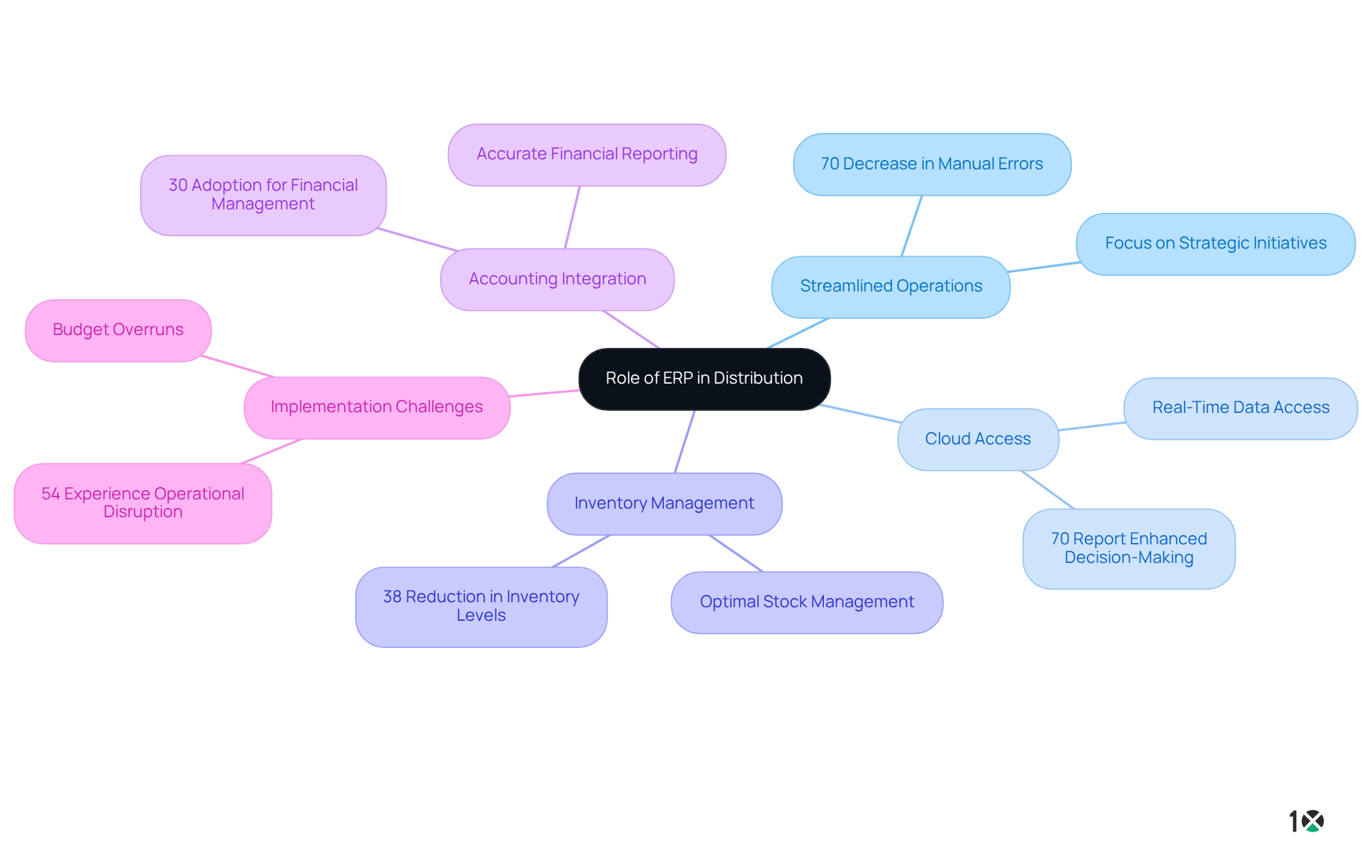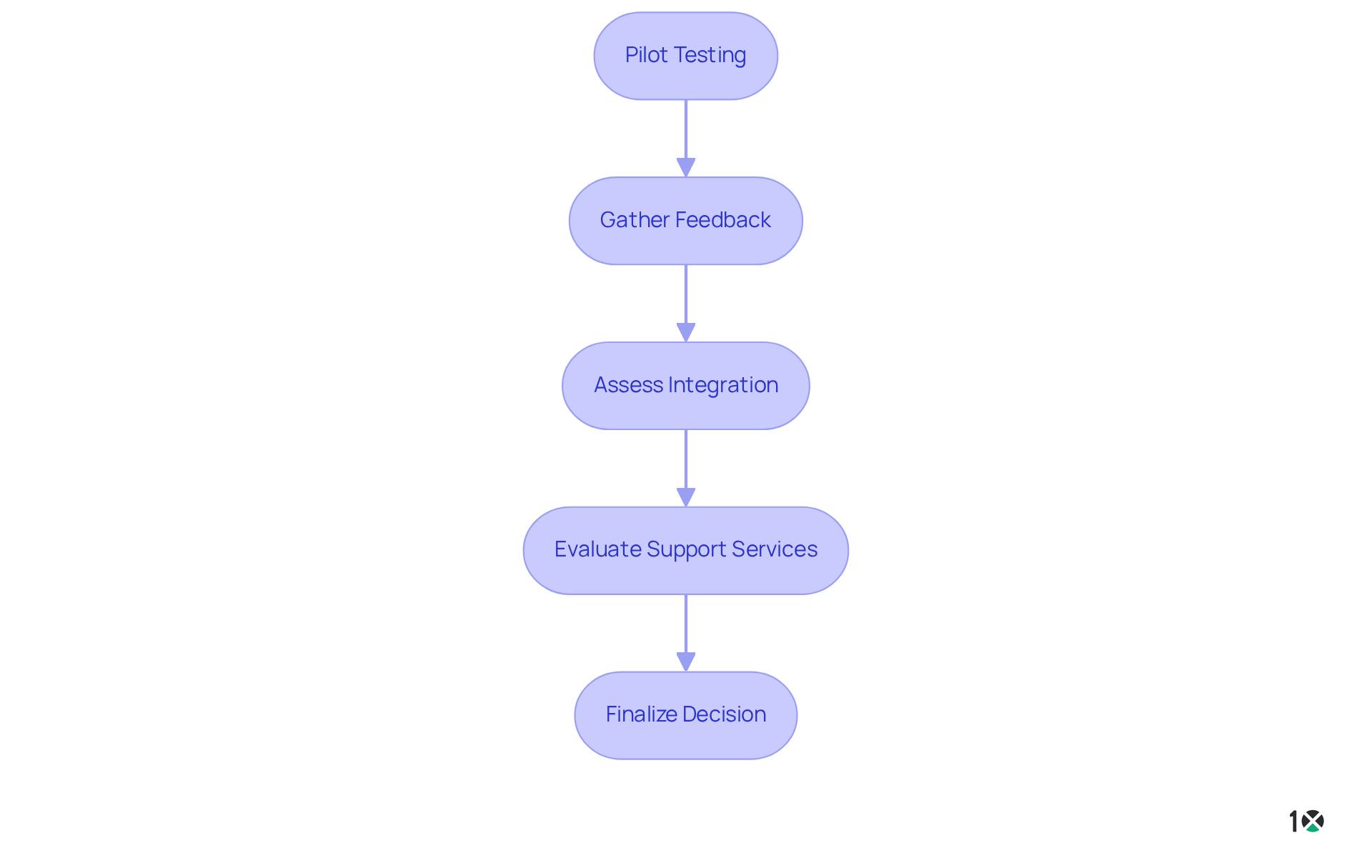Overview
Choosing the right enterprise resource planning (ERP) solutions requires a structured approach. First, it is essential to understand ERP’s role in distribution. Next, identify key features that meet your business needs. Research various options thoroughly, and finally, rigorously test the selected solution. This methodical process is crucial. Supported by statistics on efficiency improvements and the significance of user feedback, it ensures that the chosen ERP aligns with operational needs and enhances overall business performance. By following these steps, businesses can significantly improve their operational effectiveness and achieve their strategic goals.
Introduction
Choosing the right enterprise resource planning (ERP) solution is a critical decision for businesses, especially in the dynamic distribution sector where efficiency and accuracy are paramount. Understanding the multifaceted role of ERP systems enables organizations to:
- Streamline operations
- Enhance decision-making
- Maintain optimal inventory levels
However, with numerous options available, how can companies ensure they select a solution that genuinely meets their unique needs while avoiding the common pitfalls that can lead to operational disruptions? This guide explores essential steps for evaluating and choosing the most suitable ERP solutions, empowering businesses to navigate the complexities of implementation with confidence.
Understand the Role of ERP in Distribution
Enterprise resource planning solutions are essential for the distribution sector, as they integrate various business processes into a single, efficient platform. Consider the following key aspects:
- Streamlined Operations: Automating routine tasks through enterprise resource planning solutions significantly reduces manual errors, enabling staff to focus on strategic initiatives. This automation can lead to a remarkable 70% decrease in manual errors, enhancing accuracy—a vital advantage recognized by numerous organizations.
- Cloud-based enterprise resource planning solutions provide distributors with real-time data access from any location, facilitating informed decision-making. This capability is crucial; 70% of organizations utilizing ERP analytics report enhanced decision-making, underscoring the efficiency of these tools in improving business insights.
- Effective enterprise resource planning solutions provide comprehensive tools for tracking inventory levels, managing stock across various locations, and forecasting demand. Implementing ERP can result in a 38% reduction in inventory levels, ensuring optimal stock management—essential for maintaining efficiency in distribution operations.
- Accounting Integration: A robust enterprise resource planning solutions seamlessly integrate accounting functions, which enables accurate financial reporting and compliance with regulations. This integration enhances financial management, a key reason over 30% of organizations adopt ERP solutions, highlighting its significance in achieving success.
Understanding these roles allows distributors to recognize the considerable advantages of investing in enterprise resource planning solutions that are tailored to their functional requirements, ultimately improving efficiency and productivity. Additionally, it is important to acknowledge that 54% of companies experience operational disruption upon going live with an ERP solution, serving as a cautionary reminder for operations managers considering implementation.

Identify Key Features and Requirements for Your Business
To effectively choose enterprise resource planning solutions, start by identifying the key features that are essential for your distribution business.
-
Inventory Management: Prioritize features that enable lot and serial tracking, customizable attributes, and real-time stock visibility. Effective inventory management is crucial; indeed, 95% of businesses report significant improvements in process times and centralized data management after implementing enterprise resource planning solutions.
-
Accounting Capabilities: Ensure the ERP includes robust accounting features such as real-time data processing, adaptable permissions, and comprehensive reporting. This functionality empowers stakeholders to make informed decisions, with 89% of companies identifying accounting as the most critical function of their enterprise resource planning solutions.
-
User-Friendly Interface: A modern, intuitive interface can significantly enhance user adoption and satisfaction. With 71% of companies believing that decisions are delayed without access to enterprise resource planning solutions data, a user-friendly design is essential for efficiency.
-
Integration Capabilities: The ability to seamlessly integrate with other software applications is vital for maintaining operational efficiency. As businesses increasingly embrace cloud solutions, 62.7% of organizations favor cloud-based ERP applications over on-premise software, highlighting the necessity for compatibility.
-
Scalability: Select a solution that can expand alongside your business, accommodating increased transactions and participants without compromising performance. The global market for enterprise resource planning solutions is projected to reach $78.40 billion by 2026, making the selection of a scalable solution essential for long-term success.
By compiling a list of these requirements, you can streamline your search for the right enterprise resource planning solutions, ensuring they meet the unique needs of your distribution operations.

Research and Compare ERP Solutions
To effectively research and compare available ERP solutions, follow these steps:
-
Online Reviews and Ratings: Utilize platforms like G2, Capterra, and Trustpilot to investigate feedback and evaluations of different ERP solutions. These platforms offer valuable insights into consumer satisfaction and system performance, essential for making informed decisions. Notably, 89% of users of enterprise resource planning solutions cite efficiency improvements as a top benefit, highlighting the positive outcomes of effective enterprise resource planning solutions implementations.
-
Vendor Websites: Visit the websites of potential ERP vendors to gather comprehensive information about their offerings, features, and pricing structures. This direct source clarifies how each solution aligns with your specific operational needs.
-
Request Demos: Schedule demonstrations with vendors to observe the software in action. This practical experience enables you to pose specific inquiries and evaluate how effectively the enterprise resource planning solutions address your business needs.
-
Consult Industry Peers: Engage with other distributors in your network to gain insights and recommendations based on their experiences with ERP systems. Peer feedback can highlight practical advantages and potential pitfalls of enterprise resource planning solutions that may not be evident from vendor materials. Be aware that 38% of companies go over budget during ERP implementation, so understanding these challenges is essential.
-
Compare Pricing Models: Analyze the pricing structures of different solutions, taking into account both upfront costs and ongoing expenses. The average expense per individual for enterprise resource planning solutions implementation is roughly $9,000, making it crucial to comprehend the total cost of ownership to ensure that the selected enterprise resource planning solutions align with your budget.
Conducting thorough research and comparisons will help you narrow down your options to a shortlist of enterprise resource planning solutions that effectively meet your operational requirements. With 67% of ERP implementations noted as successful among manufacturers and distributors, utilizing reviews and expert insights can greatly improve your decision-making process.

Test and Validate Your ERP Choice
After narrowing down your options, it is essential to rigorously test and validate your ERP choice:
- Pilot Testing: Deploy the ERP solution on a limited scale within your organization to assess its functionality and participant experience. This initial phase allows you to identify strengths and weaknesses before a full rollout.
- Gather Feedback: Actively involve key stakeholders and end-users during the pilot phase to collect valuable feedback on the system’s performance and usability. Involving participants early can significantly improve the implementation process, as 83% of organizations indicate their ERP projects achieved ROI expectations when input from participants is prioritized. This underscores the critical role of user feedback in ensuring a successful ERP implementation.
- Assess Integration: Ensure that the ERP integrates seamlessly with your existing systems and processes. Timely recognition of possible integration problems can avert expensive interruptions later, as 54% of companies face challenges during ERP go-live. Addressing these issues early on is crucial for a smooth transition.
- Evaluate Support Services: Test the vendor’s customer support by reaching out with questions or issues during the pilot phase. Assessing their responsiveness and effectiveness is crucial, as strong support can greatly influence user satisfaction and overall success. In fact, 40% of businesses report reduced IT costs after deploying ERP technology, which can be attributed to effective vendor support.
- Finalize Decision: Based on the pilot results and feedback, make an informed decision on whether to proceed with full implementation or explore other options. This comprehensive assessment procedure is essential for guaranteeing that the selected enterprise resource planning solutions align with your business requirements and enhance efficiency.
As Peter Gross notes, “For an ERP implementation to succeed, you must commit your top employees to the core team for the project’s duration.” By thoroughly testing and validating your ERP choice, you can ensure that it aligns with your business needs and enhances operational efficiency.

Conclusion
Choosing the right enterprise resource planning (ERP) solution is a critical decision that can significantly impact the efficiency and productivity of distribution businesses. Understanding the vital role of ERP systems in streamlining operations, providing real-time data access, managing inventory, and integrating accounting functions allows organizations to make informed choices that align with their specific needs.
This article outlines a structured approach to selecting the most suitable ERP solutions. Key steps include:
- Identifying essential features such as inventory management and accounting capabilities
- Conducting thorough research and comparisons of available options
- Rigorously testing and validating the chosen solution
By emphasizing the importance of user feedback and integration capabilities, businesses can minimize disruptions and maximize the benefits of their ERP implementation.
Ultimately, investing time and resources in selecting the right ERP solution is essential for achieving operational excellence. As businesses navigate the complexities of distribution, leveraging effective ERP systems can lead to improved decision-making, enhanced accuracy, and substantial cost savings. The significance of this choice cannot be overstated; a well-implemented ERP solution not only drives efficiency but also positions companies for long-term success in a competitive landscape.
Frequently Asked Questions
What is the role of ERP in the distribution sector?
ERP (Enterprise Resource Planning) solutions integrate various business processes into a single platform, streamlining operations and enhancing efficiency in the distribution sector.
How do ERP solutions improve operational efficiency?
ERP solutions automate routine tasks, significantly reducing manual errors by up to 70%, which allows staff to focus on strategic initiatives and enhances overall accuracy.
What benefits do cloud-based ERP solutions offer?
Cloud-based ERP solutions provide distributors with real-time data access from any location, facilitating informed decision-making. About 70% of organizations using ERP analytics report improved decision-making.
How does ERP help with inventory management?
Effective ERP solutions offer tools for tracking inventory levels, managing stock across various locations, and forecasting demand, which can lead to a 38% reduction in inventory levels.
What is the significance of accounting integration in ERP solutions?
ERP solutions integrate accounting functions to enable accurate financial reporting and regulatory compliance, enhancing financial management. This integration is a key reason why over 30% of organizations adopt ERP solutions.
What should distributors consider before implementing an ERP solution?
Distributors should be aware that 54% of companies experience operational disruption when going live with an ERP solution, which serves as a caution for operations managers during implementation.
What are the overall advantages of investing in ERP solutions for distributors?
Investing in tailored ERP solutions can significantly improve efficiency and productivity in distribution operations by streamlining processes and enhancing decision-making capabilities.
